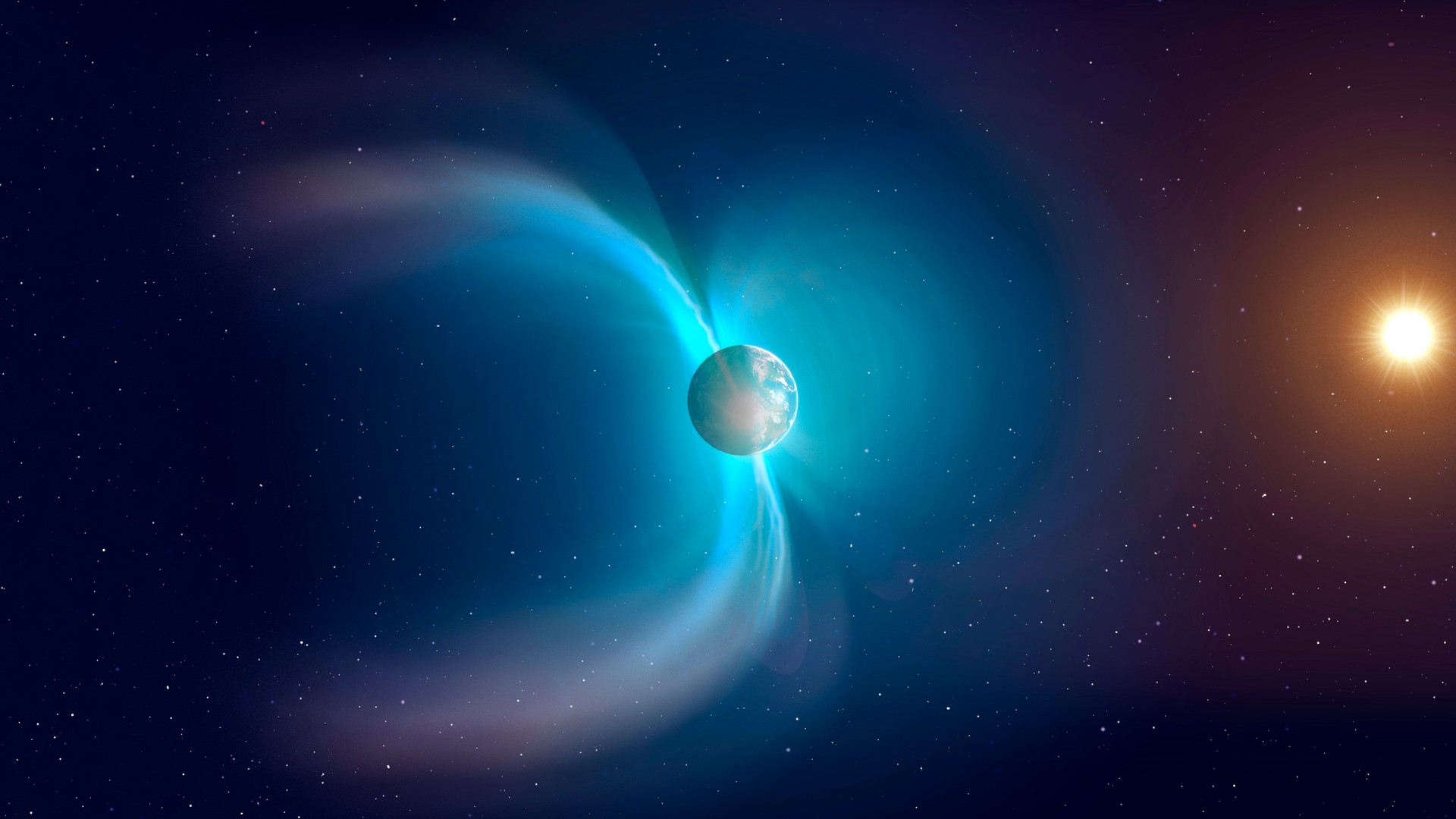Why do Earth's magnetic poles flip?
Every so often, Earth's magnetic poles completely flip. What causes this to happen? And how do these reversals affect life on Earth?


Why do Earth's magnetic poles flip: TL;DR
Ancient rocks reveal that Earth's magnetic field has 'flipped' or reversed several times in our planet's past. These reversals of Earth's magnetic poles cannot be predicted, however, because they are caused by the flow of molten rock deep within Earth, which is violent and chaotic. When Earth's magnetic poles reverse, this can cause a period of reduced geomagnetic field intensity, which can increase the amount of harmful charged particles that reach spacecraft in orbit.
Earth, our rocky, watery oasis in the cosmos is the ideal place for life to flourish for a number of reasons.
We sit at just the right distance from our home star for liquid water to exist on the planet's surface. The gravitational pull of other large planets helps protect us from apocalyptic collisions with wandering meteorites. And the planet's magnetic field encircles Earth with a protective barrier that shields us from charged particles hurtling through space.
Earth's magnetic field is generated by the complex flow of molten metallic material in the outer core of the planet. The flow of this material is affected both by the rotation of Earth and the presence of a solid iron core, which results in a dipolar magnetic field where the axis roughly aligns with the rotational axis of the planet.
Hidden in the chemical composition of ancient rocks are clues that Earth's magnetic field is a dynamic, shifting phenomena. Cooling magma rich in iron minerals is pulled into alignment with Earth's magnetic field, similar to how a needle is pulled to point towards north on a compass. The study of ancient geomagnetic fields recorded in rocks is the subject of a discipline known as "paleomagnetism."
Paleomagnetic research has provided scientists with the knowledge that Earth's magnetic field has shifted and even reversed in polarity many times in the geological past. But why?
Related: Earth's magnetic field: Explained
Breaking space news, the latest updates on rocket launches, skywatching events and more!
What causes the magnetic poles to flip?
Earth's magnetic field varies at very short timescales and extremely long ones, ranging from milliseconds to millions of years. The interaction of the magnetic field with charged particles in space can alter it at short timescales, while perturbations in the magnetic field at longer timescales are caused by internal processes unfolding in the outer liquid core of the Earth.
"Secular variation of the geomagnetic field results from the effect of advection of the magnetic field by the flow in the fluid outer core and from effects of magnetic field diffusion in the core and the mantle," geophysicist Leonardo Sagnotti told Space.com.
Fluctuations in the magnetic field caused by the movement of metallic material in the outer core have brought about full reversals of the magnetic field's polarity in Earth's past. Paleomagnetic studies which have studied previous states of the magnetic field have shown there are two possible states of polarity — the current 'normal' state, where the lines of force of the field enter towards the center of the Earth in the northern hemisphere and exit towards the outside of the Earth in the southern hemisphere. The inverse, or 'reverse' polarity is also equally as probable and stable.
Paleomagnetic studies have shown that polarity reversals of Earth's magnetic field are not periodic and cannot be predicted. This is largely because of the behavior of the mechanisms that are responsible for it.
"The flow of the metallic fluid (mostly molten iron) in the outer core of the Earth is chaotic and turbulent. Polarity reversals occur during periods of low geomagnetic field intensity, during which the intensity of the dipolar component drastically decreases, and the structure of the field is unstable," says Sagnotti.
The transitory period of polarity reversal appears as a geologically instantaneous (i.e below the geological resolution), with a duration spanning up to a few thousand years.
How do magnetic pole reversals affect life on Earth?
When the magnetic field is prone to flipping, it is in a state of reduced intensity, resulting in a greater exposure of Earth's atmosphere to solar wind and cosmic rays in the form of charged particles. A recent study showed that during the Laschamps excursion, a recent period of low magnetic field intensity which occurred only 41,000 years ago, the global cosmic ray flux reaching the Earth's atmosphere was up to three times higher than today's value.
Currently, there is no significant evidence of a correlation between mass extinctions of life on Earth and geomagnetic polarity reversals. However, linking rates of species extinction and speciation with periods of low magnetic field intensity is hindered by uncertainties in the known timescale of these magnetic 'flips'.
Additionally, magnetic reversals happen frequently on geological timescales (several hundred times in the past 160 million years), while recorded mass extinction events occur every hundred million years or so (much less frequently).
In terms of human civilization, it is not the shifting of the magnetic poles that is directly concerning, but the resulting period of reduced geomagnetic field intensity. Society is growing increasingly reliant on technology, and the effects of a reduced magnetic field intensity should be seriously considered by governments and international organizations.
"In this configuration there would be a notable increase in the penetration of charged particles into the magnetosphere at altitudes closer to the Earth's surface, with important repercussions on our technological world," adds Sagnotti.
The risks to which our planet and civilization is exposed could have significant impacts on civil society, how we do commerce, security, communications, power infrastructure, satellites and the lives of people in low Earth orbit. Unfortunately, the sporadic nature of magnetic variations and reversals means we cannot predict when exactly this will happen, all we know is that it will happen.

Conor Feehly is a New Zealand-based science writer. He has earned a master's in science communication from the University of Otago, Dunedin. His writing has appeared in Cosmos Magazine, Discover Magazine and ScienceAlert. His writing largely covers topics relating to neuroscience and psychology, although he also enjoys writing about a number of scientific subjects ranging from astrophysics to archaeology.

